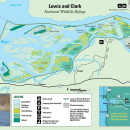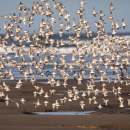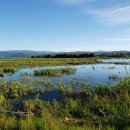Visit Us
National wildlife refuges offer us all a chance to unplug from the stresses of daily life and reconnect with our natural surroundings. Named for the famed explorers, Meriwether Lewis and William Clark, the landscape and rich wildlife of this refuge have changed very little in the past 200 years. Modern-day explorers visit this refuge to experience its wilderness qualities and enjoy the abundant wildlife resources. Lewis and Clark NWR is only accessible by boat. Native species of migratory birds, wild salmon, and other native plants and animals thrive where natural processes take precedence within the varied habitats of Sitka spruce swamps, riparian riparian
Definition of riparian habitat or riparian areas.
Learn more about riparian forest, tidal marshes, mudflats, and sand bars typical of the Columbia River estuary.
Activities
Click on the Activities below to learn more! Lewis and Clark NWR is only accessible by boat.
Related Documents
Other Facilities in the Complex
Lewis and Clark National Wildlife Refuge is managed as part of the Willapa National Wildlife Refuge Complex. A National Wildlife Refuge Complex is an administrative grouping of two or more refuges, wildlife management areas or other refuge conservation areas that are primarily managed from a central office location. Refuges are grouped into a complex structure structure
Something temporarily or permanently constructed, built, or placed; and constructed of natural or manufactured parts including, but not limited to, a building, shed, cabin, porch, bridge, walkway, stair steps, sign, landing, platform, dock, rack, fence, telecommunication device, antennae, fish cleaning table, satellite dish/mount, or well head.
Learn more about structure because they occur in a similar ecological region, such as a watershed or specific habitat type, and have a related purpose and management needs. Typically, a project leader or complex manager oversees the general management of all refuges within the complex and refuge managers are responsible for operations at specific refuges. Supporting staff, composed of administrative, law enforcement, refuge manager, biological, visitor services, and maintenance professionals, are generally, but not always, centrally located and support all refuges within the complex.
Other refuges in the Willapa National Wildlife Refuge Complex include Willapa National Wildlife Refuge and the Julia Butler Hansen Refuge for the Columbian White-tailed Deer.
The Complex Headquarters Office is located at 7112 67th Place, Long Beach, WA 98631.
Rules and Policies
National Wildlife Refuges are places where wildlife comes first, and although people are welcome, activities are regulated and monitored to ensure that impacts are minimal to the plants and animals that call the refuge home, and so future generations can continue to enjoy for years to come.
Refuge Hours
Visitors are welcome to enjoy the refuge every day from sunrise to sunset. Lewis and Clark NWR is only accessible by boat.
Hiking
Public entry on the refuge islands is limited to foot travel only. There are no trails.
Dogs
Dogs are not allowed on the refuge except for dogs engaged in authorized hunting activities.
Bicycles
Bicycles are not allowed on the refuge.
Take Only Memories (and photos!)
Please do not collect or move archeological or historic objects, or any natural material such as plants, mushrooms, berries, and antler sheds. If you pick something up to take a closer look, put it back where you found it.
Camping
Camping is not allowed on the refuge. Nearby campgrounds are located in Skamokawa and Cathlamet, WA and in and near Astoria, OR.
Fires
Fires are prohibited.
Hunting
Hunting of waterfowl, coot, and snipe is permitted on designated areas of the refuge. All state regulations apply to hunting on the refuge. Julia Butler Hansen Refuge for the Columbian White-tailed Deer has lands in both Washington and Oregon, please know where you are and follow state regulations.
Fishing
Bank fishing is permitted from the Mainland Unit shorelines adjoining Elochoman and Columbia Rivers as well as Steamboat and Brooks Sloughs, and the shorelines of Refuge islands located in Oregon, in accordance with State fishing regulations. Bank Fishing is permitted in the pond adjacent to the Diking District pumping station by Brooks Slough. Areas of the mainland Unit not listed above are closed to fishing. All state regulations apply.
Closures
Areas within refuge boundaries may be closed to public entry due to sensitive species or restoration activities. Be aware of signs indicating closed areas. The Center Road Trail is closed to all public entry from October through May, including foot travel, to minimize impact on wildlife. Please pay special attention at gates and other points of entry to determine if the area is open.
ATVs and Horses are not allowed on the Refuge.
Drones are not allowed on the Refuge, please leave the flying to the birds.
Launching, flying and landing drones on the Refuge disturbs wildlife.
Locations













The Lewis and Clark National Wildlife Refuge consists of several units, spread out among islands located in the Columbia River between Washington and Oregon, and a small portion of shoreline in Oregon
Directions to the Refuge Office, located at Julia Butler Hansen Refuge:
The office is located along Highway 4 in Cathlamet, WA. Coming from the East, it is approximately 2-miles past Cathlamet. Coming from the West, it is approximately 4-miles past Skamokawa. Turn onto Steamboat Rd to enter the refuge.




